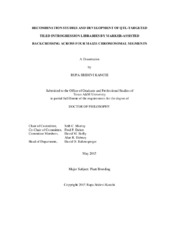| dc.description.abstract | Biological characterization of causal genomic variants present in large numbers within a quantitative trait locus (QTL) interval is a challenging problem. QTL-targeted tiling paths of near-isogenic lines (NILs) are useful in fine mapping and gene cloning, and in estimating the effects of closely linked loci. However, their development is costly and involves recurrent cycles of selection-recombination-repetition in a breeding
program.
In the first project, a distance-based strategy for fractionating loci into tiled introgression libraries using marker-assisted backcross selection is proposed. Computer simulations were used to investigate the efficiency of the proposed selection strategy in separately producing NIL sets with, on average, 3, 1.5 and 1 cM introgressions across target QTL regions of 15 cM. The proposed distance-based strategy identified NIL sets that led to better control and elimination of linkage drag using fewer backcross generations and smaller progeny sizes. Increasing BC1 progeny size (>150) had little and increasing the number of backcross individuals per selected individual (NBSI) had significant positive effect on the genomic composition of the NILs and length of backcrossing. More NBSI and backcrossing generations were required to produce NILs with smaller (1.5 and 1 cM) when compared to the larger (3 cM) average introgression lengths.
In the second project, recombination patterns across four previously identified maize photoperiod QTLs (ZmPR1-4) were evaluated based on multiple genetic backgrounds. Marker data from the first backcross generation of crosses between seven tropical and two temperate inbred lines were used. It was found that recombination rates varied between the four photoperiod QTLs. The ZmPR2 region was most recombinogenic while the ZmPR4 region was least recombinogenic among the four QTLs evaluated. The distributions of recombinations along the four ZmPR regions were consistent, and seemed to be uniform within the ZmPR2 and ZmPR4 regions. Within the ZmPR3 region, a 4.221 Mbp region containing at least two orders of magnitude higher recombination than the maize genome average was found. This study suggests that increased marker density will need to be used to gain valid estimates of the genetic diversity for recombination rates. | en |


